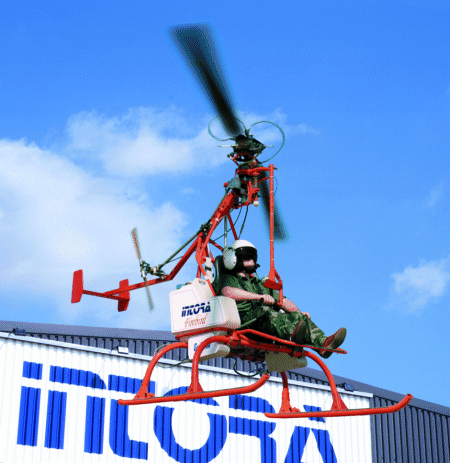The UK's Intora-Firebird is to offer its Firebird hydrogen peroxide-powered rotorcraft in the US Department of Defense's competition to acquire a vertical take-off and landing (VTOL) unmanned air vehicle (UAV) for the US Navy and Marine Corps.

The company joins a list of contenders for the VTOL UAV programme which includes Bell Helicopter Textron with the Eagle Eye, a Bombardier/Raytheon team with the CL-327 Guardian, Science Applications International (SAIC) with the Vigilante, and a Northrop Grumman/Schweizer Aircraft venture with the RoboCopter 300, a derivative of the standard single-piston Schweizer 300CB light helicopter.
Intora-Firebird officials say the Firebird does not use conventional propulsion, but is powered by rocket engines on the tips of the two rotor blades. It consumes 85% hydrogen peroxide fuel, which is converted within the jets into superheated steam and oxygen. The resulting hot gas is released rearward as a supersonic jet at the tips of the blades.
The USN has initiated a fast-track VTOL Tactical UAV (VTUAV) procurement, with the draft request for proposals due out on 17 May. Engineering and manufacturing development would start in 2000, with the first vehicles fielded three years later. The USMC is seeking 11 systems, each with four air vehicles, and the USN requires 12 systems.
"We have decided to pursue involvement in the VTOL project," says Intora-Firebird. "That is, to submit a bid. But we need to see how the Firebird system fits the established performance matrix. Our opinion is that we satisfy about 95%." The company briefed the USNavy programme office on 3 March.
The Firebird was conceived as an inexpensive light helicopter - it holds a UK Civil Aviation Authority experimental aircraft certification rating - but company executives are concentrating efforts on the UAV market, which includes law enforcement, border patrol, special operations and maritime missions.
The Firebird has completed several hundred flight hours and is ready for production. The company says it would sell for $40,000 - significantly less than its known competitors in the US military UAV contest.
Source: Flight International























